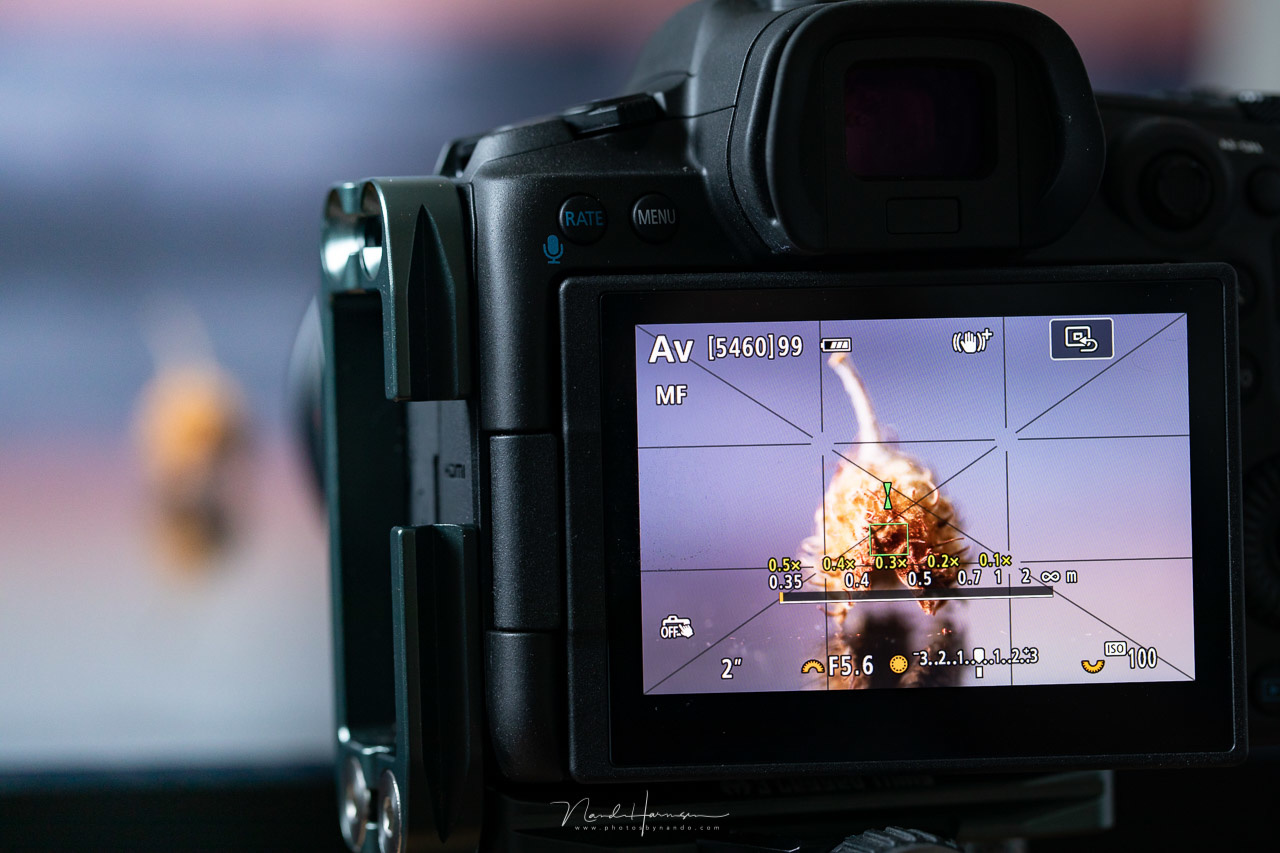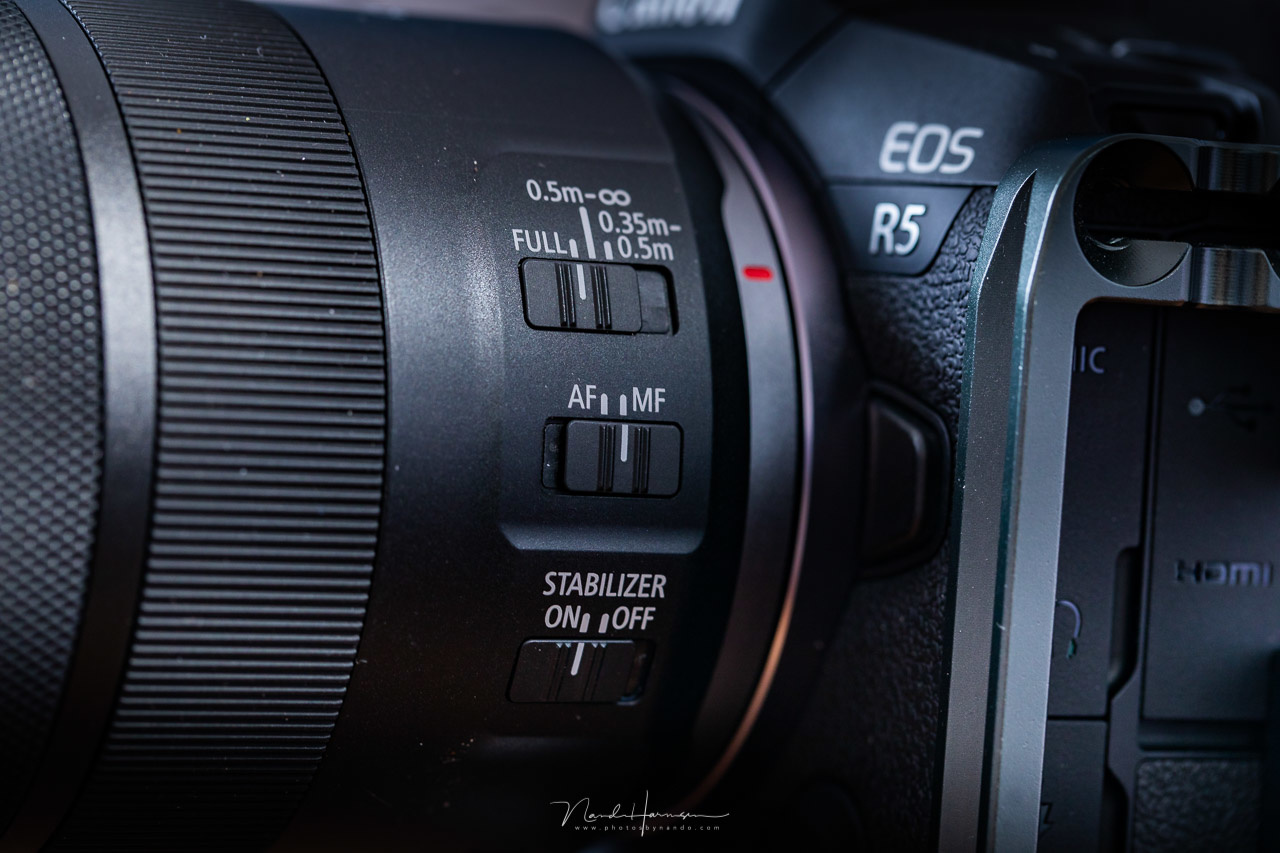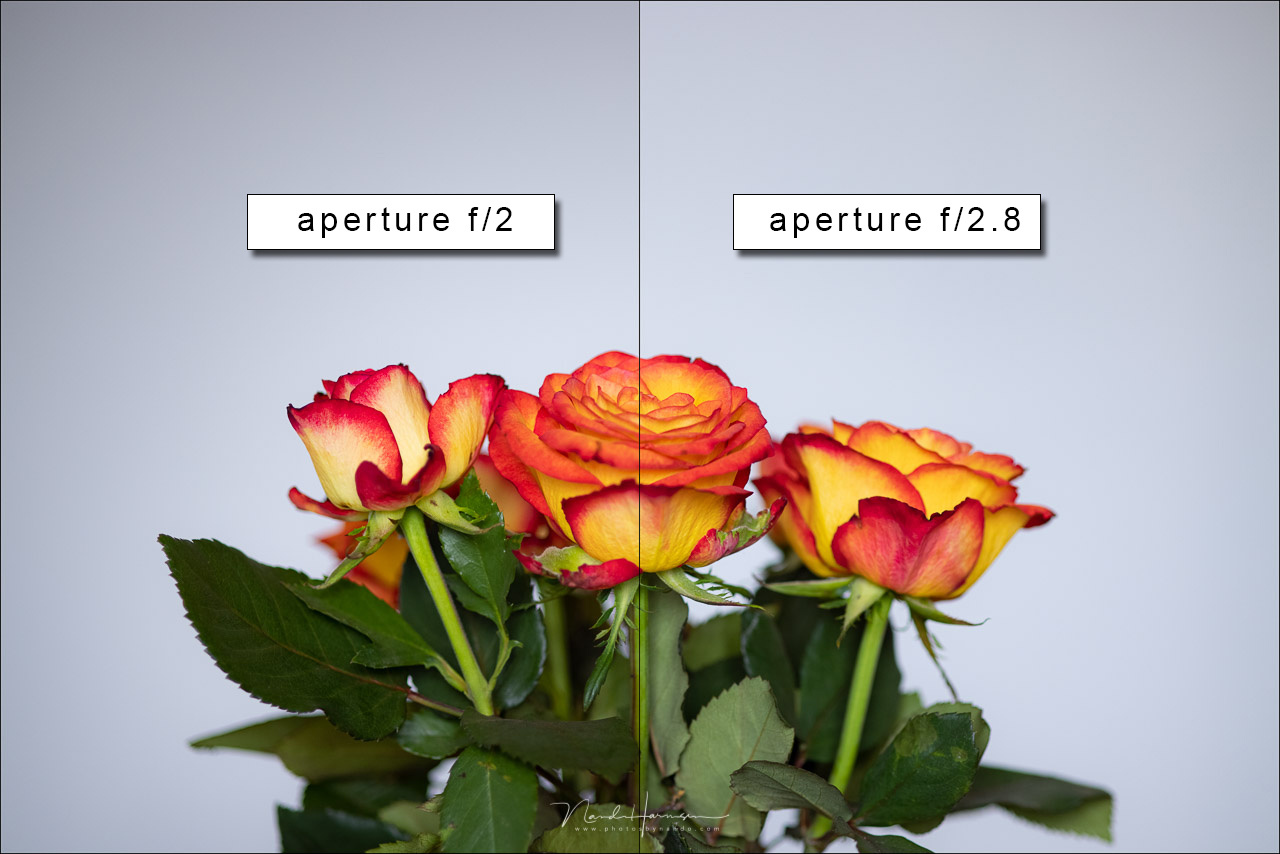Canon released an amazing 85mm lens. It is small, light, and perfect for portraits. It is also a macro lens, making it very versatile, especially for a wedding photographer. Canon Netherlands provided this lens for an extensive review.
There are a lot of wonderful lenses for the Canon RF system. The L lenses are amazing, although these are very expensive. Everyone is talking almost exclusively about these lenses, ignoring the less expensive versions. The Canon RF 85mm f/2 Macro IS STM is one of those lenses. It is a real gem, and the price is just a fraction of the Canon RF 85mm f/1.2L lens.
The Look and the Options
The Canon RF 85mm f/2 Macro IS STM is a nice small lens, weighing only 500 grams. It measures 3.1 x 3.6 inches and balances very well when fitted on a Canon mirrorless camera. The low weight is achieved by using plastics for the lens. Although it doesn’t have the very high-quality build of an L-lens, the construction has a very good feel to it. Only the lens bayonet is made of metal, which is a good choice, since that part will suffer the most wear and tear.
The lens is provided with the typical RF programmable control ring and a couple of switches to activate the image stabilization, focus limiter, and autofocus. The switches do not stick out too much, and a small part is raised just enough to operate them even with gloves.
Focusing
The Canon RF 85mm f/2 macro uses a focus by wire system. This is typical for the type of autofocus motor this lens has. The STM in the name of the lens stands for Stepping Motor, which can focus fast and accurately. Even so, it might feel slow if the focus distance change is very long. The focus limiter is very helpful in that regard.
The stepping motor is almost inaudible. Together with the accurate autofocus, this lens is ideal for filming. Only when a long focus distance change is needed will it give a slight buzz. The person who is filming with this lens should take this into account, although an external microphone will eliminate this altogether.

Reaching the minimum focus distance will increase the length of the lens. You need power to retract the lens.
The lens uses a linear focus adjustment only. It is not possible to change it to a variable speed adjustment. It means you will have to turn the focus ring 1,080 degrees to change the focus from infinity to the minimum focus distance of 13.8 inches. This is three full rotations. When reaching the minimum focus distance, the lens protrudes significantly, making it much longer.
Because it has a focus by wire system, you will need to power the lens in order to return it to its shortest size. This can be done automatically when the option is selected in the camera menu. When changing the lens while the camera is turned on, a protruded lens barrel will stay at that length. You will need to attach the lens again to return it.
Image Stabilization
The Canon RF 85mm f/2 Macro has image stabilization that is rated at five stops. If you combine this with the In-Camera Image Stabilization, like in the Canon EOS R5 and Canon EOS R6, it will reach up to eight stops. You will be able to shoot handheld with a shutter speed of approximately 0.5 seconds, based on the 1/[focal length] rule. I tried this with the high-resolution Canon EOS R5 and succeeded, but only just. You will need a very steady hand for this shutter speed.
In real-life situations, I think the lens will help stabilize up to 1/15 second, but only for your own movements. If the subject moves, it won’t be of much use. When using the macro capability of this lens, it will also be much more difficult to hold the lens steady, even with the image stabilization. Small movements will show up very quickly if the magnification rate reaches its maximum.
It Is a Macro Lens
Yes, the Canon RF 85mm f/2 is a macro lens also. Its minimum focus distance is 13.8 inches, which leads to a 0.5x magnification. This means a subject that is about 3.5 x 2.3 inches will fit the frame of a full frame camera at the minimum focus distance.

The difference between a 1:2 and 1:1 reproduction ratio. At the left is shot with the RF 85mm f/2 Macro, at the right with the EF 100mm f/2.8L Macro. Both shot on a Canon R5 (with RF-EF adapter for the EF lens).
Photographers who like to shoot "real macro" might find this not enough. After all, it isn’t the 1:1 reproduction ratio of a "real" macro lens. But even a 1:2 reproduction rate is a very nice addition to this lens, especially for wedding photographers, who love to shoot nice tight portraits and need to shoot some semi-macro of the wedding rings also. Now, they can do this with just one lens.
But besides weddings, this lens is perfect for shooting still life scenes. It gives a lot of flexibility, being able to change the focus distance without many limitations. It is also very handy for shooting flowers and mushrooms, situations where a 1:1 reproduction rate is rarely necessary.
One thing I did like about the Canon RF 85mm f/2 Macro was the nice focus bar on the LCD screen when using manual focus. Because the focus turn is very long, it becomes very easy for an accurately manually focus. Together with the focus assist of the camera, the shallow depth of f/2 will pose no problem. The focus bar also mentions the magnification rate, which is a nice addition.

The manual focus bar will provide very accurate focusing when combined with the 1,080-degree turn of the focusing ring.
A Word About Image Quality
Chromatic aberration shows up at f/2, with purple and green fringing depending on the focal depth. By stopping down the lens, it becomes less prominent and almost completely gone at f/5.6 Besides these details, the lens delivers a very sharp image, even with a high-resolution camera like the Canon EOS R5.
My Conclusion
At first, I was skeptical about the Canon RF 85mm f/2 macro IS STM, mainly because of its build and focusing system. But the size and weight made the lens very interesting. After a few days, I became enthusiastic, especially after a model shoot. The lens performed very well. It was fast, accurate, and delivered a wonderfully sharp result with my Canon EOS R5.
I did some macro testing and found it to be much fun to use. Especially with manual focus, it is very easy to achieve accurate focus, even with a very shallow depth of field. I didn’t mind the 1:2 reproduction rate. But for the real macro photographer, it might feel a bit limiting. A wedding photographer will appreciate the macro capabilities. It is enough for the pictures of the rings during a wedding day.

A couple of roses and some water drops shot with the RF 85mm f/2 Macro on a Canon R5. I used two Profoto A1 flash guns for the light.
One thing I didn’t like was the protruding lens barrel. It is not very convenient, because it is stays at length if you don't turn off the camera before switching lenses. This was also the reason why I sold my old Canon EF 85mm f/1.2L II lens and replaced it with the Canon EF 85mm f/1.4L IS. The protruding lens barrel might be less of a problem if it is only a few millimeters, but in this case, it can stick out quite a lot. I wouldn’t feel comfortable in a wedding situation when I need to change lenses very quickly. The second downside is the 1,080 degrees focus turn and the lack of variable speed. You only have a linear response from the focusing ring.
Besides these small issues, I find the Canon RF 85mm f/2 macro IS STM a wonderful lens that produces sharp results. Combined with a very friendly price, it is a lens that I highly recommend.
What I Like
- Small and lightweight
- Metal lens bayonet
- A large aperture (f/2) for a shallow depth of field
- Image stabilization rated up to 5 stops (up to 8 stops with IBIS)
- 1,080 degrees focus ring rotation for accurate manual focusing
- Accurate and fast STM focus system
- Focus limiter present
- Image sharpness is very good
- Price
What I Don’t Like
- Made of plastic (although it still has a quality feel to it)
- No internal focus system
- Only linear focusing possible, no variable speed
- The lens needs to be retracted before turning the camera off
- Macro has only a 1:2 reproduction rate
- CA is quite prominent at f/2
- No weather-sealing
What do you think about this lens? Would you consider buying this one, or do you prefer the much more expensive L version of this lens, which offers an f/1.2 aperture? I also would like to know what you think about the macro capabilities. Please let me know in the comments below. You can purchase yours here.
Many thanks to Canon Netherlands for providing me with this lens. This review is based on my own experiences and is not sponsored in any way. I received no money for reviewing this lens, and I'm not connected to Canon in any way.
If you're passionate about taking your photography to the next level but aren't sure where to dive in, check out the Well-Rounded Photographer tutorial where you can learn eight different genres of photography in one place. If you purchase it now, or any of our other tutorials, you can save a 15% by using "ARTICLE" at checkout.
















Another quality review and sample pictures - thank you Nando! Are you planning to review the F/1.2 RF beasts?
Thank you, Tammie.
I have a RF 50mm f/1,2L lens available, but I have no real comparison. Perhaps I will write something about it when I have enough images to show. But I must say, I really am impressed by this f/1,2L lens.. It is an amazing piece of glass. Also amazing expensive. hahaha
Nando Harmsen did you test this lens in any of the video modes? Just curious how the autofocus performs on the video side (if there's any hunting for focus or if it racks smoothly).
No, I am afraid not. But the AF works very smooth while having it on servo-AF, tracking eyes and face.
Thank you for asking, it is something I should do also next time.
No worries, thanks for the great review. All of the RF glass has been solid for video work in my experience so far, so I imagine this one is no different.
I shoot Banyan Tree figures.
I have observed a strange behavior of the focus ring on my copy. I have set the variable focus speed. When I turn the focus ring slowly, I need about 330 degrees for the entire path from infinity to 1:2. When I turn the focus ring quickly, I need 1080 degrees, like you. Here the focus ring reacts exactly differently than it should.
That is strange indeed.
I have received a response from Canon Germany: They were also able to reproduce the wrong behavior of the lens: It is clearly a bug. They have reported it to Canon Inc. Japan. However, there they think that everything is according to the specifications. Let's hope that Canon Japan recognizes the error after all and provides a firmware update at some point.
Maybe you from fstoppers can also try to reproduce the error and if necessary note it in your review and report it to your country headquarters of Canon? Maybe this will help to get a firmware update soon?
I have also shown the error in a short movie:
https://www.dropbox.com/s/5avtllzp1bn5l5u/focus_rf85_english.mp4?dl=0
That's crazy! I have this lens (and love it), but have always felt baffled by the manual focus rate when turning the ring. I didn't attempt to get scientific about it until I saw your comment, but my copy behaves exactly the same as yours. Now it's irritating - small focus adjustments are harder than they should be. Interesting (disappointing) that Canon hasn't released a firmware update
Very nice review. Is the function ring standard? The comments about the bug seem opposite to logic. If you move the focusing ring fast it should move the focusing plane fast. It doesn't seem a bug but a swapped function. Just a small programming glitch.